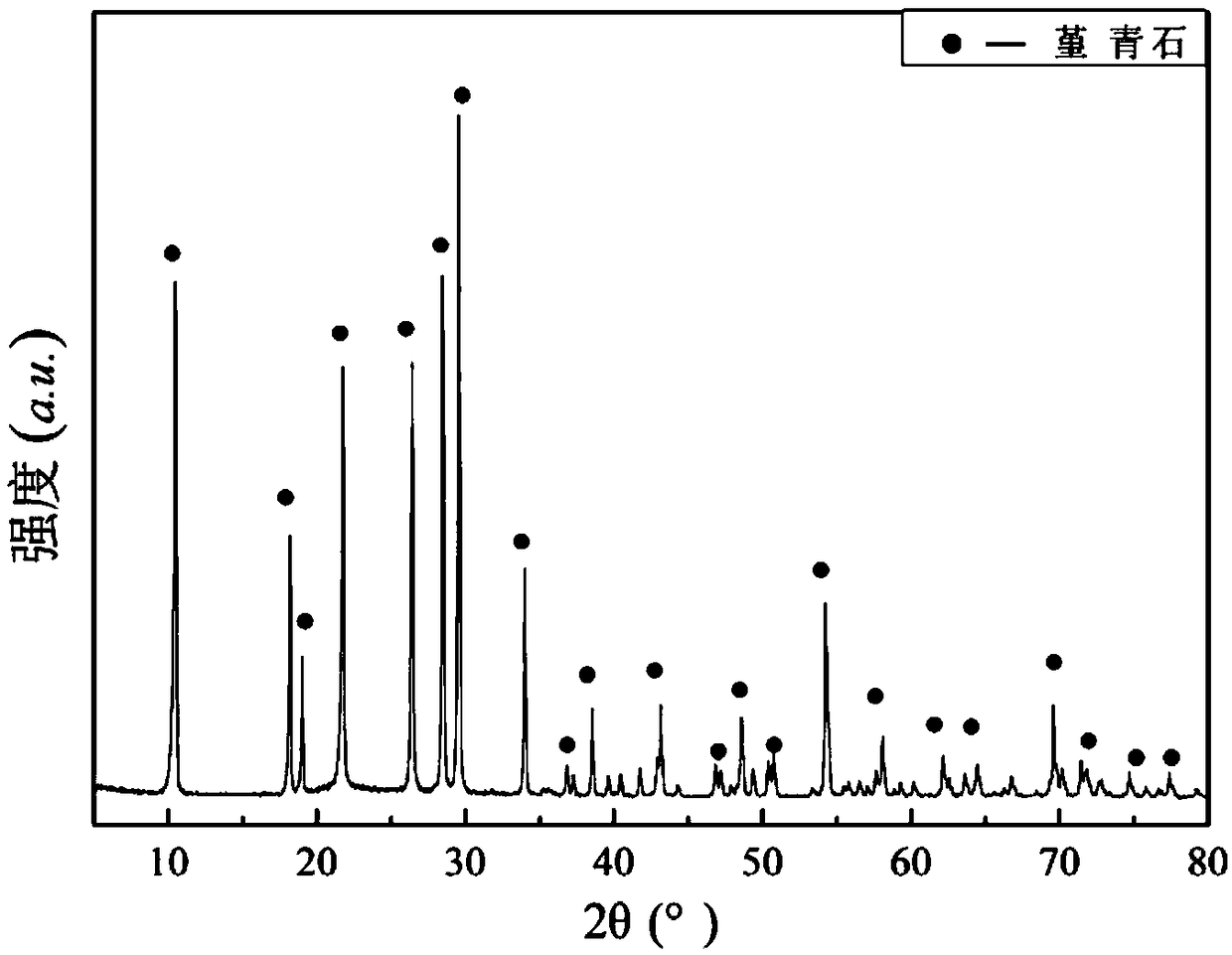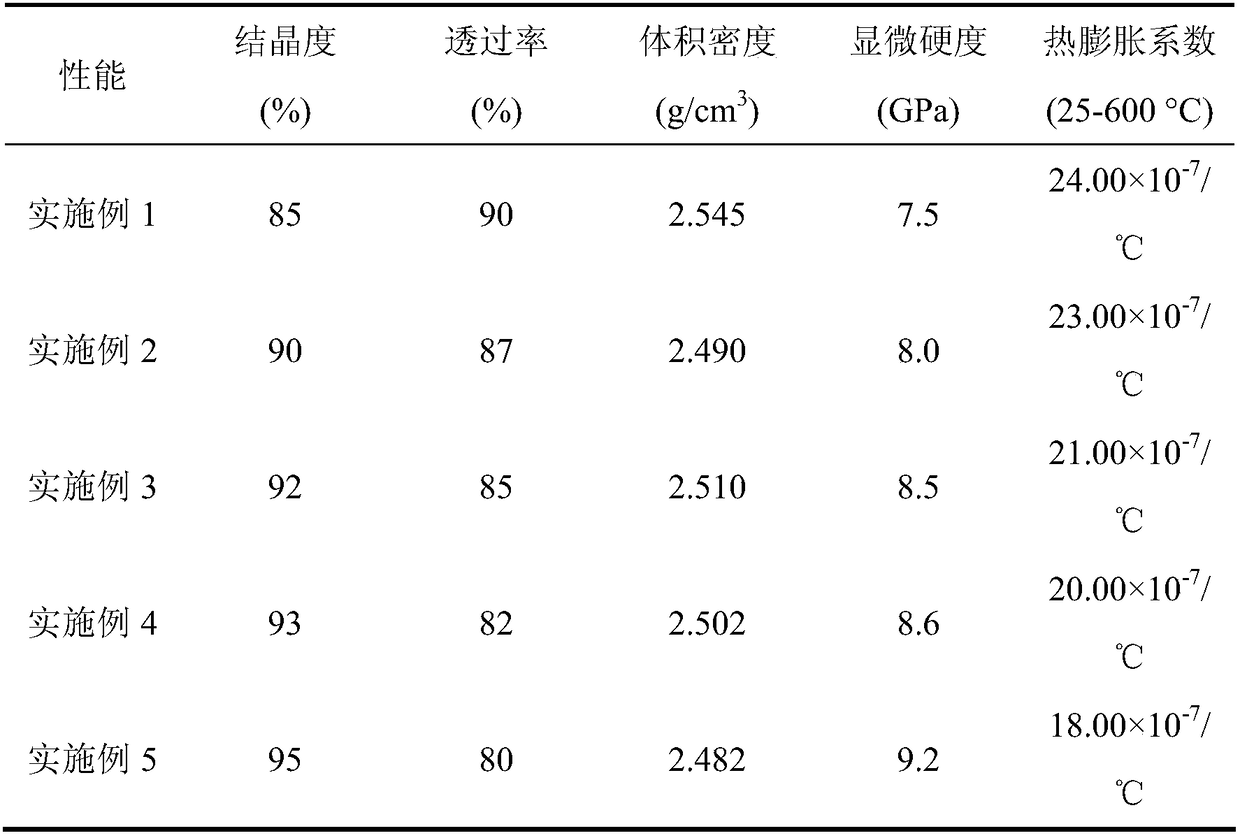Magnesium aluminum silicon system glass and preparation method of high-crystallinity-degree transparent glass-ceramic
A technology of glass-ceramics and high crystallinity, which is applied in the field of glass materials, can solve the problems of glass-ceramic property degradation, unmentioned crystallinity and transmittance of glass-ceramics, and achieve low equipment requirements, preparation methods and production The process is simple and easy to operate, and the effect of comprehensive performance is good
- Summary
- Abstract
- Description
- Claims
- Application Information
AI Technical Summary
Problems solved by technology
Method used
Image
Examples
Embodiment 1
[0023] Raw material ratio (mass) is: MgO: 16.45g, Al 2 o 3 : 41.20g, SiO 2 : 67.98g, ZrO 2 : 2.49g, TiO 2 : 1.61g, (NH 4 ) 2 HPO 4 : 5.34g, H 3 BO 3 : 2.52g and clarifying agent Sb 2 o 3 : 1.36g.
[0024] Put the raw materials into an agate mortar and grind them, mix them evenly, and get the batch materials; put the batch materials into a corundum crucible, put them into a melting furnace, first raise the furnace temperature to 1600°C, the heating rate is 5°C / min, and keep it warm for 20 minutes , and then lowered to 1560°C, the cooling rate was 10°C / min, and kept for 10 minutes, and then raised to 1600°C, the heating rate was 8°C / min, and kept for 20 minutes; finally, it was moved to a preheated mold at 600°C, and annealed for 2 hours , and cooled to room temperature to obtain the base glass. Move the basic glass into a muffle furnace for heat treatment, the heating rate is 3°C / min, first raise the furnace temperature to 780°C for nucleation, and keep it for 24 ho...
Embodiment 2
[0027] Raw material ratio (mass) is: MgO: 16.45g, Al 2 o 3 : 41.20g, SiO 2 : 65.55g, ZrO 2 : 7.47g, TiO 2 : 3.22g, H 3 BO 3 : 2.52g and clarifying agent Sb 2 o 3 : 1.35g.
[0028] Put the raw materials into an agate mortar and grind them, mix them evenly, and get the batch materials; put the batch materials into a corundum crucible, put them into a melting furnace, first raise the temperature of the furnace to 1610°C, the heating rate is 5°C / min, and keep it warm for 40 minutes , and then lowered to 1570°C, the cooling rate was 15°C / min, and kept for 10 minutes, then raised to 1610°C, the heating rate was 7°C / min, and kept for 40 minutes; finally, it was moved to a preheated mold at 620°C, and annealed for 4 hours , and cooled to room temperature to obtain the base glass. Move the basic glass into a muffle furnace for heat treatment at a heating rate of 5°C / min. First raise the furnace temperature to 800°C for nucleation and keep it for 36 hours, then raise the furnac...
Embodiment 3
[0031] Raw material ratio (mass) is: MgO: 16.45g, Al 2 o 3 : 37.08g, SiO 2 : 67.98g, ZrO 2 : 7.46g, (NH 4 ) 2 HPO 4 : 5.34g, H 3 BO 3 : 5.05g and clarifying agent Sb 2 o 3 : 1.36g.
[0032] Put the raw materials into an agate mortar and grind them, mix them evenly, and get the batch materials; put the batch materials into a corundum crucible, put them into a melting furnace, first raise the furnace temperature to 1620°C, the heating rate is 5°C / min, and keep it warm for 40 minutes , and then lowered to 1560°C with a cooling rate of 20°C / min, holding for 15 minutes, then rising to 1620°C with a heating rate of 10°C / min, holding for 40 minutes, and then falling to 1550°C with a cooling rate of 10°C / min , keep it warm for 15 minutes, then raise it to 1650°C at a heating rate of 9°C / min, keep it warm for 20 minutes; then move it to a preheated mold at 640°C, anneal for 6 hours, and cool to room temperature to get the basic glass. Move the basic glass into a muffle furna...
PUM
| Property | Measurement | Unit |
|---|---|---|
| density | aaaaa | aaaaa |
| microhardness | aaaaa | aaaaa |
| density | aaaaa | aaaaa |
Abstract
Description
Claims
Application Information
 Login to View More
Login to View More - R&D
- Intellectual Property
- Life Sciences
- Materials
- Tech Scout
- Unparalleled Data Quality
- Higher Quality Content
- 60% Fewer Hallucinations
Browse by: Latest US Patents, China's latest patents, Technical Efficacy Thesaurus, Application Domain, Technology Topic, Popular Technical Reports.
© 2025 PatSnap. All rights reserved.Legal|Privacy policy|Modern Slavery Act Transparency Statement|Sitemap|About US| Contact US: help@patsnap.com



